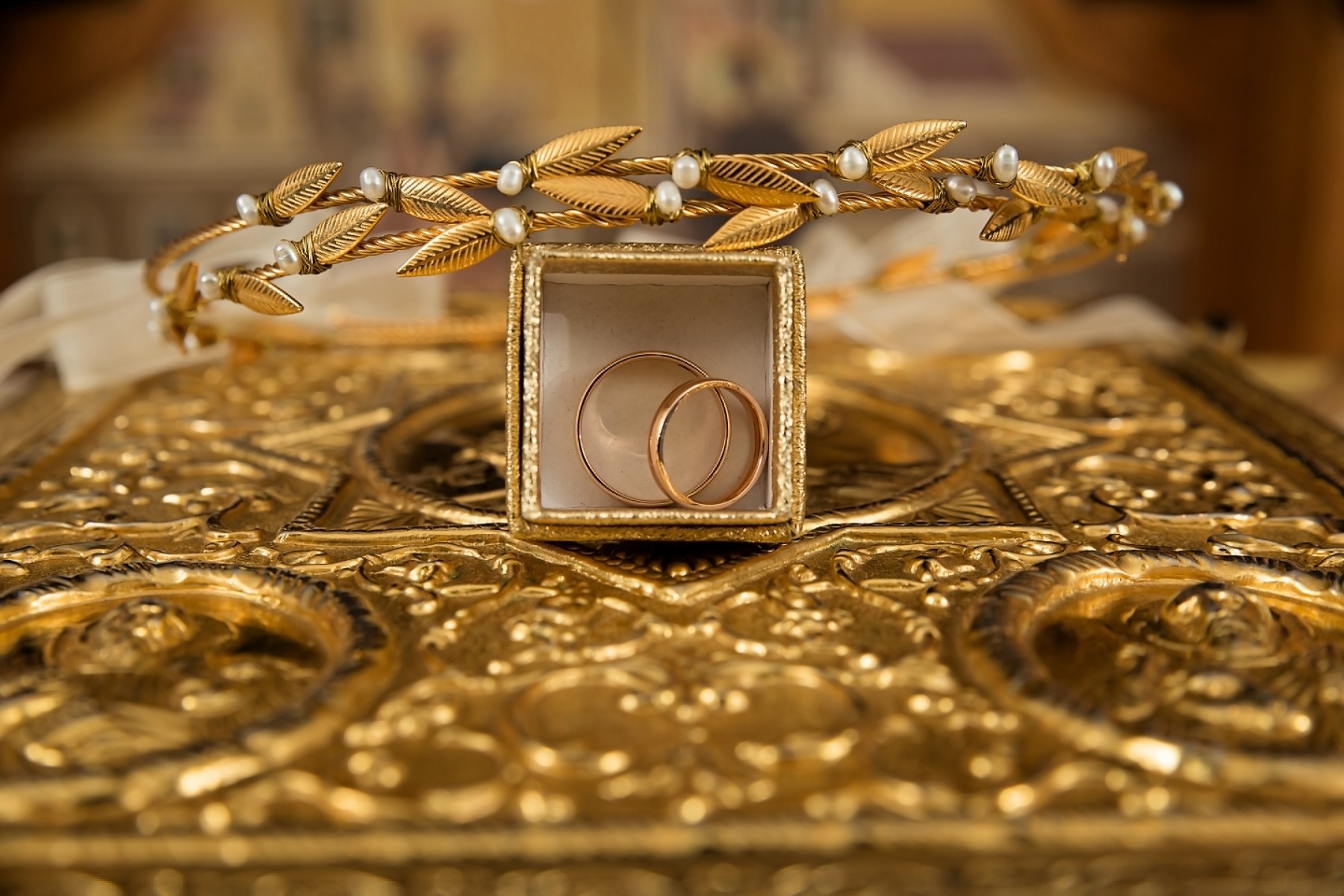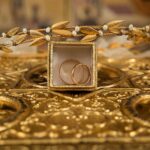
Though many jewelry fans may confuse vermeil with gold plating or filling, there is a significant difference between these three processes. All of them look the same because of the thin layer of gold covering their exteriors. Each is more valuable and long-lasting than costume jewelry due to the presence of gold, but you should still think carefully about the features of each option before adding any to your wardrobe.
Let’s start by defining what we mean by each of these terms, and then we’ll compare and contrast them to help you pick the one that’s right for you:
Gold-Filled Jewelry
Gold-filled jewelry, such as that constructed from gold-filled beads and gold-filled findings, has a much thicker layer of gold over the base metal, sometimes as much as 100% thicker than that of vermeil and gold-plated jewelry. This significantly improves the jewelry’s long-term durability. In addition, even though the base metal is typically brass or some other low-end material, the pieces are so well-made that it is nearly impossible to tell them apart from “real” gold.
Vermeil
“Vermeil” is the term for pure or sterling silver that has been gold-plated. Electroplating silver with gold, a chemical process that uses an electrical current to bind the two metals together, is now the primary method of producing vermeil jewelry.
In the United States, some criteria must be met before a piece of jewelry can be called vermeil. For instance, the piece’s gold must be 10k or higher and 2.5 microns thick.
Gold-Plated Jewelry
Gold-plated jewelry is made from a base metal such as brass or copper or an electroplating process that adds a layer of gold. Gold-plated jewelry is typically less expensive than vermeil because no minimum karat weight or thickness is required. However, a gold-plated item with a thick layer of gold may be more valuable than a vermeil item of the same design. It’s also worth noting that different karats of gold look different. For example, a 14k piece’s yellow will be paler, while an 18k piece will be more profound and prosperous.
Critical Distinctions Between Vermeil and Gold-Plated Jewelry
With gold and silver as its main components, vermeil jewelry is often placed in the same category as fine jewelry. A lot of people would classify it as “demi-fine.” Generally speaking, the greater the thickness of the gold layer and its karat weight, the more expensive and valuable the item will be. However, the gold plating on a vermeil ring or necklace will likely wear away quickly if it only has a thin coating. A thinly plated vermeil place at least occasionally requires replating.
You can think of gold-plated jewelry as vermeil jewelry with a lower-quality base metal like copper or brass instead of silver. Gold-plated accessories are not subject to the same regulations as vermeil. The electroplated gold layer can be of any thickness, and the gold itself can be of any quality.
Except where otherwise noted, gold plating on jewelry is typically done with a lower quality and a thinner gold layer. This means that if you see “gold plated” on a piece of jewelry, you need to pay extra attention to its quality. Although it is coated in gold, this does not guarantee that the piece of jewelry is of superior quality or will last a lifetime.
Distinguishing Features of Gold-Filled and Vermeil Jewelry
Gold-filled jewelry can be a high-quality addition to your collection, while gold-plated jewelry isn’t always the best option.
Instead of electroplating, the gold is bonded to the metal using heat to create gold-filled jewelry. Since the jewelry’s base metal is protected by two or three layers of gold, it won’t tarnish or change color over time. Check the thickness of the gold plating to ensure it’s at least 5% if you want to be sure the jewelry is genuine gold-filled.
When deciding between vermeil and gold filled, remember that vermeil pieces are typically made through electroplating, and the minimum required gold is much lower. Therefore, it’s essential to evaluate the layer thickness, quality of the base metal, and karat weight of the gold compared to one another. Then, considering the piece’s constituent parts, you can ascertain whether or not it satisfies your criteria. Some vermeil jewelry may tarnish quickly, but other vermeil jewelry with heavy plating may hold up, as well as gold-filled jewelry.
In other words, why do some people have reactions to gold plating?
Vermeil or gold-filled jewelry is your best bet if you have an allergy to brass, copper, or nickel. The gold plating on such items is typically too thin to protect the base metal adequately, and an allergic reaction could occur if even a tiny amount of gold wears away.
To Sum Up, What Kind Of Jewelry Should People Buy?
Vermeil with thick plating is an excellent option if you’re looking for the best semi-fine jewelry. Jewelry made of gold-filled metal is likely to last the longest and be the most wear-resistant if you aren’t picky about the quality of the base metal. While vermeil, gold-filled, or fine jewelry is ideal for special occasions like weddings and anniversaries, gold plating is all you need for everyday wear.
Vermeil and gold filled are great alternatives for the fashion-conscious on a investing budget, but pure 14k or 18k gold or platinum is always the best choice for high-quality pieces.
Thinking About Metalsmithing?
You’ve found the right place to learn how to make metal jewelry if you picture a burly man engaged in heavy work over a fire. By the way, the man in your imagination works with iron, not metal; these guys are generally referred to as blacksmiths and not metalsmiths.
Technically speaking, metalsmithing refers to the process of shaping and fabricating metal to make new jewelry.
Metals can be used to make jewelry. Precious metals like gold, silver, and platinum are the most common types of metal used in jewelry, but they are not the only ones. Artisan jewelers and metalsmiths often use silver and copper, some gold, and even brass and bronze in their pieces. In contrast, most commercial jewelers and metalworkers stick to the more familiar gold, silver, and platinum.
It is possible to make jewelry out of metal without performing some of the more fundamental steps. Below is a list of the most fundamental steps in metalworking, which may or may not occur in this specific order:
Before beginning most metal fabrication tasks, hard metal is pliable by heating it in the flame of a torch. However, when working with metal, annealing is necessary because the metal work hardens as it is hammered, bent, etc.
Metal files and steel wool can be used to smooth the cut edges of metal after they have been sawn to remove any remaining sharp edges or dangerous burs. However, you will need to do some filing and sanding later when joining two pieces of metal or shaping seams to ensure a good solder joint.
Cold connections (using rivets, weaving, screws, tabs, etc.) and hot connections (using extreme heat) are both valid methods for joining metal (soldering and fusing).
Learn to use micro torches for soldering, a process that involves joining two or more pieces of metal together with the help of solder, an alloy of metals.
The final or nearly final steps in metalsmithing are the finishing steps, which include sanding, filing, polishing, and buffing, to create smooth, comfortable, aesthetically pleasing pieces of hand-crafted metal jewelry, as well as to add the desired finish on the metal surface, such as a matte or shiny finish. The finishing process can be done entirely by hand, machine, or a combination of the two.
Add-ons for metalwork: when working with metal for jewelry, you may want to play around with different textures and patinas to create unique pieces. The metal can be textured in various ways, including by using different hammers and through processes like reticulation and milling.
Chemicals can also be used to add patinas. Stamping words, letters, designs, or simple patterns into the metal with a hammer and steel stamps is a “bonus” metalsmithing technique that allows for customizing metal jewelry.






